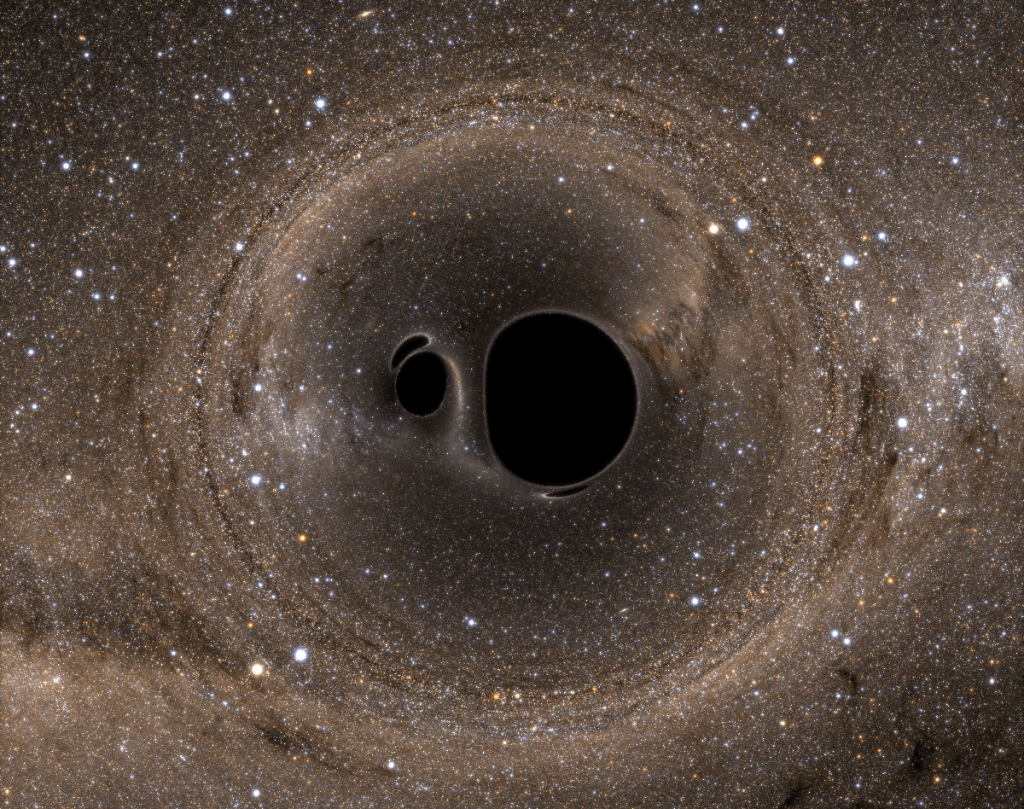In February 2016, scientists at the Laser Interferometer Gravitational-Wave Observatory (LIGO) announced the first-ever detection of gravitational waves (GWs). Originally predicted by Einstein’s Theory of General Relativity, these waves are ripples in spacetime that occur whenever massive objects (like black holes and neutron stars) merge. Since then, countless GW events have been detected by observatories across the globe – to the point where they have become an almost daily occurrence.
This has allowed astronomers to gain insight into some of the most extreme objects in the Universe. In a recent study, an international team of researchers led by Cardiff University observed a binary black hole system originally detected in 2020 by the Advanced LIGO, Virgo, and Kamioki Gravitational Wave Observatory (KAGRA). In the process, the team noticed a peculiar twisting motion (aka.
a precession) in the orbits of the two colliding black holes that was 10 billion times faster than what was noted with other precessing objects. This is the first time a precession has been observed with binary black holes, which confirms yet another phenomenon predicted by General Relativity (GR). The team was led by Professor Mark Hannam, Dr.
Charlie Hoy, and Dr. Jonathan Thompson from the Gravity Exploration Institute at Cardiff University. They were joined by researchers from the LIGO Laboratory, the Barcelona Institute of Science and Technology, the Max Planck Institute for Gravitational Physics, the Institute for Gravitational Wave Astronomy, the ARC Centre of Excellence for Gravitational Wave Discovery, the Scottish Universities Physics Alliance (SUPA), and other GW research institutes.
Binary black holes (BBHs) are considered a prime candidate for researching GWs since astronomers expect some will consist of precessing binaries. In this scenario, black holes will circle each other in ever-tightening orbits, generating an increasingly strong GW signal until they merge. However, no definitive evidence of orbital precession has been observed from the 84 BBH systems detected by Advanced LIGO and Virgo so far.
However, the team noticed something different when examining the GW200129 event detected by LIGO–Virgo–KAGRA collaboration during its third operational run (O3). One of the black holes in this system (~40 solar masses) is considered the fastest-spinning black hole ever detected through gravitational waves. Unlike all previous observations of BBHs, the system’s rapid rotation has such a profound effect on spacetime that the entire system wobbles back and forth.
This form of precession is known as Frame Dragging (aka. the Lense–Thirring effect), an interpretation of GR where gravitational forces are so strong that they “drag” the very fabric of spacetime with them. This same phenomenon is seen when observing Mercury’s orbit, which periodically precesses as it orbits the Sun.
In short, Mercury’s path around the Sun is highly eccentric, and the most distant point in its orbit (perihelion) also moves over time, rotating about the Sun like a spinning top. These observations are one of the ways GR was tested (and confirmed) after Einstein formalized it in 1916. In general, precession in general relativity is usually such a weak effect that it is almost imperceptible.
As Dr. Thompson explained in a recent Cardiff University press release: “It’s a very tricky effect to identify. Gravitational waves are extremely weak and to detect them requires the most sensitive measurement apparatus in history.
The precession is an even weaker effect buried inside the already weak signal, so we had to do a careful analysis to uncover it. ” Previously, the fastest-known example was a binary pulsar that took over 75 years for the orbit to process. In this case, the BBH known as GW200129 (observed on January 29th, 2020) processes several times a second, an effect 10 billion times as strong as the binary pulsar.
Even so, confirming that the black holes in this system were precessing was a significant challenge. Said Dr. Hoy, who is now a researcher at the University of Portsmouth: “So far, most black holes we’ve found with gravitational waves have been spinning fairly slowly.
The larger black hole in this binary, which was about 40 times more massive than the Sun, was spinning almost as fast as physically possible. Our current models of how binaries form suggest this one was extremely rare, maybe a one-in-a-thousand event. Or it could be a sign that our models need to change.
” These results confirm that before black holes merge – the most extreme gravitational event astronomers have ever observed – BBHs can experience an orbital precession. It is also the latest in a long line of examples that demonstrate how GW astronomy allows astronomers to probe the laws of physics under the most extreme conditions imaginable. With a network consisting of Advanced LIGO, Virgo, and KAGRA detectors in the US, Europe, and Japan, it is also one of the most vibrant fields of astronomical research.
This network is currently being upgraded to enhance its sensitivity to GW events and will commence its fourth round of observations (O4) in 2023. When this happens, it is hoped that several hundred black hole collisions will be detected and added to the GW catalog. This will allow astronomers to gain greater insight into the most extreme gravitational phenomenon in the Universe and let them know if GW200129 was an outlier or if such extreme events are a common occurrence.
This research was funded by the Science and Technology Facilities Council (STFC) – part of the UK Research and Innovation (UKRI) organization – and the European Commission’s European Research Council (ERC). The paper that describes their findings, titled “General-relativistic precession in a black-hole binary,” recently appeared in the journal Nature. Further Reading: Cardiff University, Nature The post Shortly Before They Collided, two Black Holes Tangled Spacetime up Into Knots appeared first on Universe Today.
.
From: universetoday
URL: https://www.universetoday.com/158086/shortly-before-they-collided-two-black-holes-tangled-spacetime-up-into-knots/



